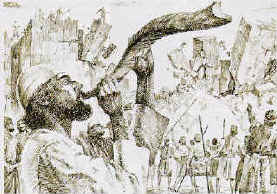 The idea that Athanasius’ thirty-ninth Festal Letter (367 AD) contains the first complete extant list of the New Testament Canon is common. It is not just a common belief among layman, but it is even taught by many Bible scholars and professors of Church history. I believed this for quite some time and even referred to the New Testament Canon as the Athanasius Canon when discussing what the Church historically recognized. Many have gone so far as to label Athanasius the Father of the Canon. The problem with all of this is that it is simply wrong. Over a century before Athanasius penned his Festal Letter, Origen provided a list (ca. 250 AD) that appears to be that of the recognized New Testament books. In his Homilies on Joshua, Origen wrote:
The idea that Athanasius’ thirty-ninth Festal Letter (367 AD) contains the first complete extant list of the New Testament Canon is common. It is not just a common belief among layman, but it is even taught by many Bible scholars and professors of Church history. I believed this for quite some time and even referred to the New Testament Canon as the Athanasius Canon when discussing what the Church historically recognized. Many have gone so far as to label Athanasius the Father of the Canon. The problem with all of this is that it is simply wrong. Over a century before Athanasius penned his Festal Letter, Origen provided a list (ca. 250 AD) that appears to be that of the recognized New Testament books. In his Homilies on Joshua, Origen wrote:
But when our Lord Jesus Christ comes…he sends priests, his apostles, bearing “trumpets hammered thin,” [Num. 10:2] the magnificent and heavenly instruction of proclamation. Matthew first sounded the priestly trumpet in his Gospel; Mark also; Luke and John each played their own priestly trumpets. Even Peter cries out with trumpets in two of his epistles; also James and Jude. In addition, John also sounds the trumpet through his epistles [and Apocalypse], and Luke, as he describes the Acts of the Apostles. And now that last one comes, the one who said, “I think God displays us apostles last,” [1 Cor. 4:9] and in fourteen of his epistles, thundering with trumpets, he casts down the walls of Jericho and all of the devices of idolatry and dogmas of philosophers, all the way to the foundations.[1]
This list totals twenty-seven books, all of which are in Athanasius’ purported first canon. To be fair there is a little bit of room for criticism. The book of Hebrews is not identified by name. However, Origen held that Hebrews was likely written by Paul. It is almost certainly then this fourteenth epistle. I added text in brackets to include John’s Apocalypse (i.e. Revelation) for two reasons. The first of which is that some Greek manuscripts do include it. The second reason is that the Apocalypse is an epistle and would naturally be listed among John’s others. And again, that is only if the inclusion of the Apocalypse is not native to the original. The issues with Hebrews and the Apocalypse are quite minor. The natural assumption would be that Origen had them in mind.
Among those who are even aware of Origen’s list, the objection to it being an exhaustive one of recognized New Testament Scripture lies in Origen not explicitly saying it was canon. Though when the passage is considered, it is hard to arrive at any other conclusion. In expected Origen fashion he uses florid allegory in discussing these books. Origen uses a similar allegory to name the same authors in the same exact order with, “Isaac, therefore, digs also new wells, nay rather Isaac’s servants dig them. Isaac’s servants are Matthew, Mark, Luke, John; his servants are Peter, James, Jude; the apostle Paul is his servant. These all dig the wells of the New Testament.”[2]
The books are compared to the trumpets that demolished the walls of Jericho. They are spoken as corporately overcoming the world’s idols and vain philosophies of man. It would especially odd if Origen considered other books to have equal weight to these and not mention them here. Likewise, it would be highly inconsistent to include a book not considered to be God-breathed among those that were in this illustration. In addition, Origen taught that the canon had been completed with the writings of the apostles.[3] Not only does Origen’s list significantly predate Athanasius’, but the twenty-seven books are spoken of as if their authority was already commonly accepted.
Note: When investigating the first appearance of the New Testament canon we are only looking to when it was first delineated by man. The Canon was completed the very instant that John finished writing Revelation in 95-96 AD. It is God who determined what books made up the Bible. Men merely recognized what God had done.
[1] Origen, Homilies on Joshua, ed. Barbara J. Bruce (Washington, D.C.: CUA Press, 2002), 74–75.
[2] Origen, Homilies on Genesis and Exodus, ed. Ronald E. Heine (Washington, D.C.: CUA Press, 2010), 188.
[3] Commentary on the Gospel of Matthew. Bk. 10. Ch. 12.

I learned that Athanasius’ list was to rule out the assertions of Marcion which had lasted for the last couple centuries prior. It was already commonly understood that the present Canon was to be accepted as the Objective Standard at that time… Athanasius only solidified this notion as a matter of fact in opposition to Marcionism… I absolutely agree with you about Origen having already determined these books himself to he authoritative long before Athanasius.
Agreed, agreed.
One question, though:
Let us stipulate that Origen is using the correct 27 books here, and that he thinks of these books as uniquely to be honored and held in highest esteem and deemed “God-breathed.”
What does he regard as the purpose of this collection, though?
I mean: Assuming that he has some special category in his mind for these particular books, what is the purpose of that category? What does Origen think we’re supposed to do with books of that category, as opposed to other respected and wholly-orthodox books (e.g. the letters of Ignatius of Antioch) which don’t quite make it in?
We can’t just casually say, “He thinks of them as THE CANON.” That would be misleading; if we do that, we’ll bring in anachronistic notions: Substituting what WE think when we say “the canon” for what Origen would have thought.
Origen will not be thinking of it as “the rule of faith by which Christians learn what is, and is not, the sum total of all the required content of the Christian religion.” For that is the kind of thing a man separated from the time of the Apostles by over a thousand years might do: An exercise in attempting to reconstruct an ancient religion from the writings its practitioners left behind. But Origen, an Early Father, was in no such quandary!
Origen’s own doctrinal opinions and liturgical practices simply weren’t derived exclusively from what he found in those books. Except where Origen himself speculated (and often got into trouble!), he got his doctrine and liturgy from his instructors, who got them from their instructors, who got them from the Apostolic Fathers, who got them from the Apostles, who got them from Christ.
So he didn’t go into Bible-reading with the intent of reconstructing Christianity. Why should he? He already knew what Christianity was, in all its liturgical and sacramental basics, from childhood.
No, for men of Origen’s era, the New Testament books were “the memoirs of the Apostles,” in Justin Martyr’s phrase.
And given this, if Origen were to use the term “the canon,” he would have different associations in his mind from those we have. The Western mind, in reading Scripture, is dominated with the urge to prove what doctrines are true vis-a-vis various debates. We say, “whatever’s in the canon, is authoritative; and we pooh-pooh whatever isn’t.”
But for a man of Origen’s time, a “canon” — a standard — would be less about an authoritative source of doctrine, and more about standardizing the cycle of readings in the liturgy. This practice was adopted from the Jewish practice which preceded it, and lacked only the incorporation of readings from the “memoirs” (the New Testament) to become a Christian lectionary.
That the Corinthian church was including the Letter of Clement of Rome in their lectionary until the 170’s and probably later is known. So, if Origen’s 27 books represent a competing lectionary list — his own lectionary proposal — then we can say that the lectionary was not standardized any time before the late 2nd century.
So, to return to the question:
What was this group of 27 books to Origen? Did he think of it as his own lectionary list, proposed or asserted as superior to the one in Corinth (or any others)?